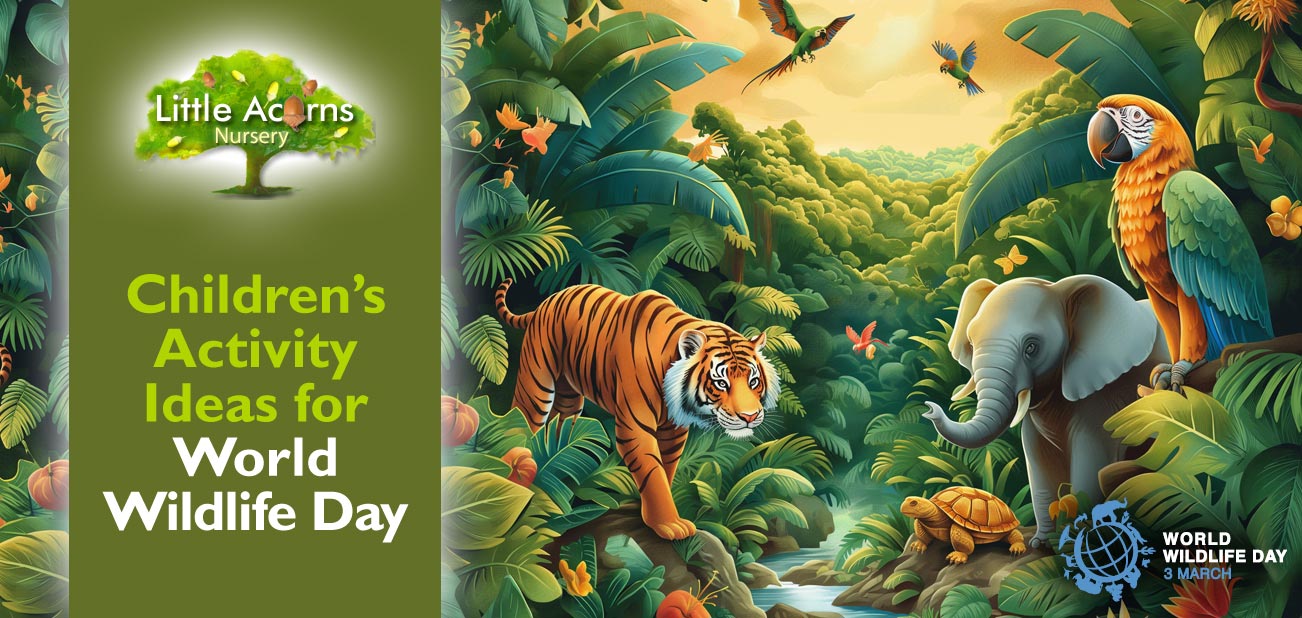
World Wildlife Day arrives in early March each year — just around the corner at the time of writing. The annual event is hugely important and very worthwhile. It is also a great opportunity to inspire children to get more interested in the natural world. By doing so, they will benefit wild animals and plants — as well as themselves through fun, learning and discovery. What’s more, many of the nature-inspired activities that we’ll suggest today are totally free.
Spending time in and around nature is incredibly good for children and World Wildlife Day offers families many opportunities to get much closer to it. As well as being great fun, such activities can open children’s eyes to humanity’s impact on the planet and help them understand the importance of looking after nature’s incredible flora and fauna. Learning about the plight of some of the Earth’s wild animals and plants will also nurture a greater respect for the natural world. It will help to encourage greener values, greater empathy, and a sense of responsibility in even the youngest children. It is also likely to instil in them a love for the great outdoors and encourage outdoor play, which is also hugely beneficial to children. With all that in mind, let’s dive into what World Wildlife Day stands for and then explore some of the children’s activities inspired by the initiative. Families right across the UK can take part, explore and discover. In so doing, they will self-improve, become more responsible citizens, and evolve into more effective stewards of this irreplaceable planet.
About World Wildlife Day
World Wildlife Day (‘WWD’) always arrives on the 3rd of March. In 2025, that will fall on a Monday, then in 2026 it’s a Tuesday — and so on. WWD is an initiative born in late 2013 at the United Nations General Assembly and is closely related to CITES, which is all about the conservation of endangered species of wild flora and fauna. So — it’s incredibly worthwhile and families can each play their part in raising awareness.
“UN World Wildlife Day has now become the global annual event dedicated to wild animals and plants.”
Activity Ideas for Children & Families
Children and families can get involved in World Wildlife Day in a variety of ways. For example, they can simply get out for walks in local parks and countryside to see some of nature’s flora and fauna, embark on activities to attract wildlife to their own gardens or, if the weather is inclement, get creative at home with some wildlife art. The only limit for possible wildlife-related activities is the imagination! That said, we’ve got some suggestions below to inspire families and children to get started.
Create Some Wildlife Art!
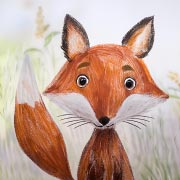 Children will love creating wildlife art. Whether it’s drawing animals and plants, making a collage, or constructing an animal out of cardboard or origami, wildlife art is a wonderful way to get children involved. What’s more, they will get a sense of satisfaction from the activity and it can help them appreciate wildlife more.
Children will love creating wildlife art. Whether it’s drawing animals and plants, making a collage, or constructing an animal out of cardboard or origami, wildlife art is a wonderful way to get children involved. What’s more, they will get a sense of satisfaction from the activity and it can help them appreciate wildlife more.
TIP: Use IFAW’s International Youth Art Contest art competition as possible inspiration. Although it’s now closed in 2025 for judging in readiness for the March event, you can view some previous entries to give your child inspiration (scroll to the bottom of that linked page to see the full gallery of examples).
Another great wildlife-related art activity is to challenge children to combine 2 or more creatures, thereby creating their own, new hybrid animal. Results can be inventive, endearing, or sometimes hilarious! [Examples].
Support a Wildlife-Related Charity
 Another incredibly worthwhile activity that children can get involved in is fundraising for a wildlife-related charity. This can be done, for example, through a sponsored activity of some kind. That could be a sponsored walk, hop, swim, or whatever children and families choose (under supervision, of course, for the youngest). A sponsored fundraising activity will not only raise funds for a wildlife charity of choice but also spread the word. Furthermore, children will get an enormous sense of achievement at the end when their actions raise vital funds for animals or conservation. Volunteering for local wildlife charities is also hugely worthwhile, of course, but it is more suited to when children are older.
Another incredibly worthwhile activity that children can get involved in is fundraising for a wildlife-related charity. This can be done, for example, through a sponsored activity of some kind. That could be a sponsored walk, hop, swim, or whatever children and families choose (under supervision, of course, for the youngest). A sponsored fundraising activity will not only raise funds for a wildlife charity of choice but also spread the word. Furthermore, children will get an enormous sense of achievement at the end when their actions raise vital funds for animals or conservation. Volunteering for local wildlife charities is also hugely worthwhile, of course, but it is more suited to when children are older.
“With over 1 million species estimated to be threatened with extinction, and facing the intensifying triple planetary crisis, innovative finance for wildlife conservation is more urgent than ever.”
Storytelling With a Wildlife Theme
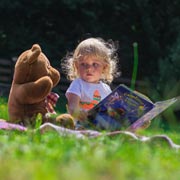 Challenging children to create stories involving wildlife and nature is both creative and fun! Adults/parents can lead by example, to begin with, so that the youngest children can get the idea. Whether the story involves feeding hungry squirrels in the forest, swimming with dolphins, going on an adventure in the jungle, or something entirely different, it’s sure to pique children’s interest. It will stimulate children’s imaginations and natural spirit of adventure as well as helping to raise awareness of some of the issues facing wildlife.
Challenging children to create stories involving wildlife and nature is both creative and fun! Adults/parents can lead by example, to begin with, so that the youngest children can get the idea. Whether the story involves feeding hungry squirrels in the forest, swimming with dolphins, going on an adventure in the jungle, or something entirely different, it’s sure to pique children’s interest. It will stimulate children’s imaginations and natural spirit of adventure as well as helping to raise awareness of some of the issues facing wildlife.
Challenge the Family to Live More Sustainably
 World Wildlife Day brings into focus the enormous challenges that affect nature’s flora and fauna. Sadly, many of those challenges are caused by humans, whether it’s due to habitat loss, global warming, or something else. By raising awareness through World Wildlife Day activities, children and families can also challenge themselves to live more sustainably. This is a whole topic in itself! However, some easy measures can be things like:
World Wildlife Day brings into focus the enormous challenges that affect nature’s flora and fauna. Sadly, many of those challenges are caused by humans, whether it’s due to habitat loss, global warming, or something else. By raising awareness through World Wildlife Day activities, children and families can also challenge themselves to live more sustainably. This is a whole topic in itself! However, some easy measures can be things like:
- cutting out food containing palm oil, which is responsible for the clearance of huge swathes of forests and jungles;
- stopping the use of harmful chemicals in the home and garden (slug killers, pesticides and weedkillers, for example);
- eating more vegetarian and vegan food options, which is better for the environment and, of course, animals;
- recycling more waste;
- using more sustainable, wildlife-friendly products in the home;
- and reducing the use of plastics.
It’s a huge topic, so some research will be needed although our examples are a great starting point and are good things to bring to children’s attention.
Visit a Local Zoo or Wildlife Sanctuary
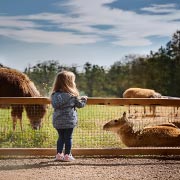 Children can also get closer to wild flora and fauna if they live near a wildlife sanctuary (or zoo) or somewhere like a national park. Nothing can really replace seeing animals and plants in real life and so it’s worth researching to find somewhere to visit close by. In Lancashire, just five miles from Little Acorns Nursery, for example, is Turbary Woods Owl & Bird of Prey Sanctuary, which is well worth a visit. There, kids can see owls, falcons, hawks and more. Visiting will support this non-profit enterprise, educate little ones and give them a wonderful day out.
Children can also get closer to wild flora and fauna if they live near a wildlife sanctuary (or zoo) or somewhere like a national park. Nothing can really replace seeing animals and plants in real life and so it’s worth researching to find somewhere to visit close by. In Lancashire, just five miles from Little Acorns Nursery, for example, is Turbary Woods Owl & Bird of Prey Sanctuary, which is well worth a visit. There, kids can see owls, falcons, hawks and more. Visiting will support this non-profit enterprise, educate little ones and give them a wonderful day out.
Plant & Food Growing
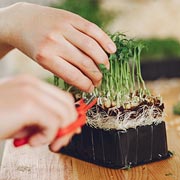 Teaching children how to grow their own plants and, better still, food is a wonderfully educational and fulfilling activity. As well as learning to appreciate wild plants growing in parks and the countryside, learning how to grow their own, at home, is also great fun. Luckily, we have a whole blog post dedicated to Food Growing for Kids, so do take a look.
Teaching children how to grow their own plants and, better still, food is a wonderfully educational and fulfilling activity. As well as learning to appreciate wild plants growing in parks and the countryside, learning how to grow their own, at home, is also great fun. Luckily, we have a whole blog post dedicated to Food Growing for Kids, so do take a look.
Take Children on a Nature Scavenger Hunt!
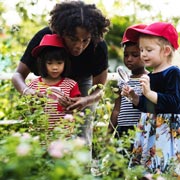 A nature scavenger hunt is also great fun and is sure to get children interested in nature, wildlife, and the outdoors. The activity involves looking out for specific natural things, for example, a pine cone, a robin, a squirrel’s drey (i.e. nest), a winged seed, or animal tracks. It will also give children exercise and get them closer to nature in a fun, engaging activity. To make it easier, check out our free Nature Hunt activity reference sheets; our Winter Nature Hunt activity is here and, for later in the year, our Autumn Nature Hunt can be found here. We’ll be adding more to that series in due course.
A nature scavenger hunt is also great fun and is sure to get children interested in nature, wildlife, and the outdoors. The activity involves looking out for specific natural things, for example, a pine cone, a robin, a squirrel’s drey (i.e. nest), a winged seed, or animal tracks. It will also give children exercise and get them closer to nature in a fun, engaging activity. To make it easier, check out our free Nature Hunt activity reference sheets; our Winter Nature Hunt activity is here and, for later in the year, our Autumn Nature Hunt can be found here. We’ll be adding more to that series in due course.
Animal & Bird Spotting
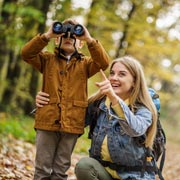 Encouraging (and supervising, where appropriate) an activity where children try to see different types of animals, birds, and insects is also a wonderful way to get them interested in nature. To make it easier, we have published some free, downloadable reference sheets, which also double as posters, for families to use during this activity. These include one for British birds, another for British land mammals, one for British butterflies, and one for minibeasts that children are likely to find in gardens and compost heaps.
Encouraging (and supervising, where appropriate) an activity where children try to see different types of animals, birds, and insects is also a wonderful way to get them interested in nature. To make it easier, we have published some free, downloadable reference sheets, which also double as posters, for families to use during this activity. These include one for British birds, another for British land mammals, one for British butterflies, and one for minibeasts that children are likely to find in gardens and compost heaps.
Attracting Wildlife to Your Garden
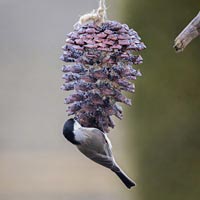 If children like the idea of attracting birds and other wildlife to their own garden, there are many easy ways to make this possible. As well as putting out suitable food to attract birds, children can help make a quiet, wild area with a compost heap to attract minibeasts. There are so many ways to attract wildlife so, to get you started, check out our wildlife-friendly flower-growing activity here, our make-your-own bird feeders activity and then be sure to read our guide to bird feeding for under-fives. And don’t forget — ditch the harmful chemicals like weedkillers, pesticides, slug and snail killers. After all, if a bird or animal eats something affected, it will also then be in danger from such poisons — and beautiful pollinators like bees and butterflies are being decimated by pesticides. Our children are tomorrow’s stewards of the planet, so it’s important to educate them to form good habits and show empathy towards wildlife.
If children like the idea of attracting birds and other wildlife to their own garden, there are many easy ways to make this possible. As well as putting out suitable food to attract birds, children can help make a quiet, wild area with a compost heap to attract minibeasts. There are so many ways to attract wildlife so, to get you started, check out our wildlife-friendly flower-growing activity here, our make-your-own bird feeders activity and then be sure to read our guide to bird feeding for under-fives. And don’t forget — ditch the harmful chemicals like weedkillers, pesticides, slug and snail killers. After all, if a bird or animal eats something affected, it will also then be in danger from such poisons — and beautiful pollinators like bees and butterflies are being decimated by pesticides. Our children are tomorrow’s stewards of the planet, so it’s important to educate them to form good habits and show empathy towards wildlife.
These are Learning Opportunities
As a parent, you’ll notice that these activities are learning opportunities for children and also include many teachable moments. Through such activities, children will begin to understand the impact that they have on other living things around them and the environment as a whole. They can then adopt greener values, improve feelings of empathy, and understand how to be more responsible citizens. In short, they can self-improve while making the world a better place. Such is the power of the opportunity that World Wildlife Day offers to families who celebrate it. Enjoy!
A Childcare Place at Little Acorns Nursery, Clayton-le-Woods
Weekday Childcare for Babies, Toddlers & Preschoolers Near Chorley

 The staff at Little Acorns Nursery in Clayton-le-Woods hope that families enjoy today’s post and the activities suggested therein. We know how important nature is to children and, indeed, have our own gardens where children can connect with nature and enjoy the freedom of outdoor activities.
The staff at Little Acorns Nursery in Clayton-le-Woods hope that families enjoy today’s post and the activities suggested therein. We know how important nature is to children and, indeed, have our own gardens where children can connect with nature and enjoy the freedom of outdoor activities.
If you’d like to consider a possible nursery place for your baby or child at Little Acorns, please get in touch using one of the options below. We support many of the government’s childcare funding schemes including free childcare for eligible babies from 9 months of age. As well as being a nursery and preschool for families in Clayton-le-Woods and Chorley, we may also suit those nearby in Clayton Brook, Clayton Green, Thorpe Green, Pippin Street, Buckshaw Village, Whittle-le-Woods, Farington, Bamber Bridge, Lostock Hall, Euxton, Leyland and Penwortham.


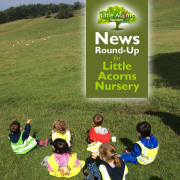
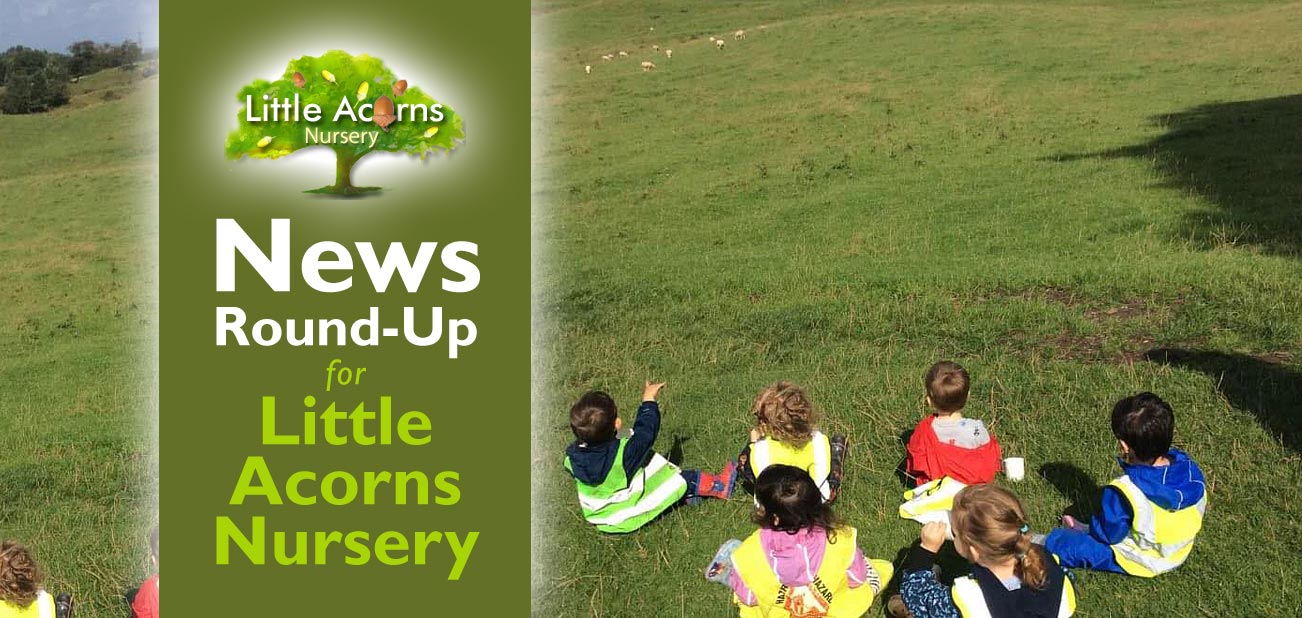
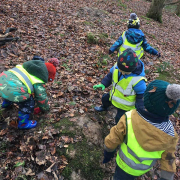
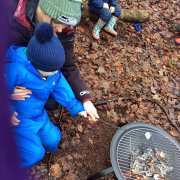
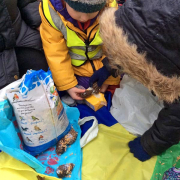

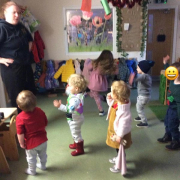

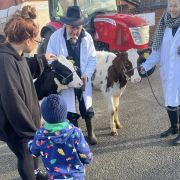



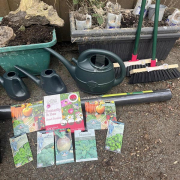

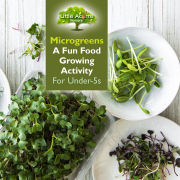
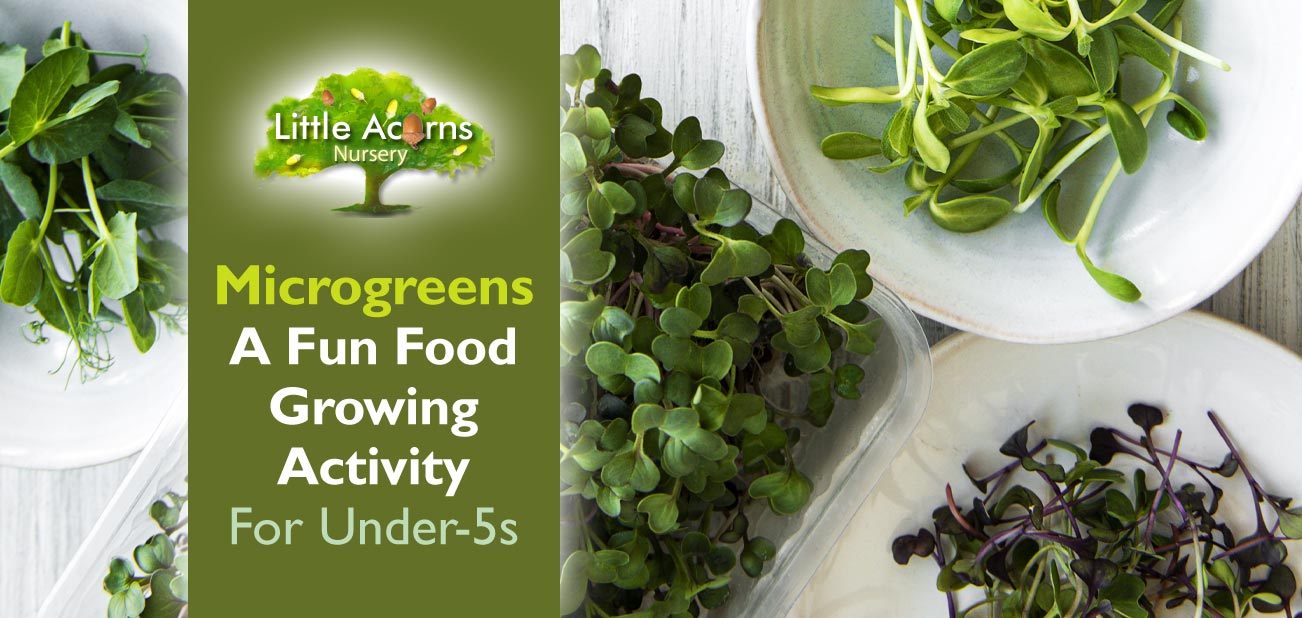
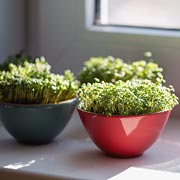 As promised in our recent
As promised in our recent  Microgreens, also known as micro leaves, are the young shoots of growing plants that are edible. Examples include the seedlings of herbs like basil and coriander, red cabbage micro leaves and the shoots from root vegetables like beetroot. When growing, the seedlings form a thick and rich ‘carpet’ of shoots that, when ready, can be snipped off en masse and used in meals as salads or garnishes. What’s more, they’re delicious, highly nutritious and make meals look amazing. The entire activity can also be accomplished indoors in any home. You do not need to have a garden because a well-lit windowsill or counter top will more than suffice.
Microgreens, also known as micro leaves, are the young shoots of growing plants that are edible. Examples include the seedlings of herbs like basil and coriander, red cabbage micro leaves and the shoots from root vegetables like beetroot. When growing, the seedlings form a thick and rich ‘carpet’ of shoots that, when ready, can be snipped off en masse and used in meals as salads or garnishes. What’s more, they’re delicious, highly nutritious and make meals look amazing. The entire activity can also be accomplished indoors in any home. You do not need to have a garden because a well-lit windowsill or counter top will more than suffice.
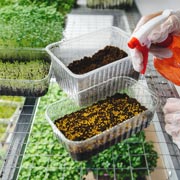 Microgreen seeds. These are available inexpensively online or at places like garden centres and even some supermarkets. You can buy microgreen mixed seeds or choose seeds for rocket, beetroot, spinach, red cabbage, fennel, broccoli, radish or mustard. Each has a distinctive look, when growing, and flavour, when eaten. Read the packets for more detail or just have fun and experiment!
Microgreen seeds. These are available inexpensively online or at places like garden centres and even some supermarkets. You can buy microgreen mixed seeds or choose seeds for rocket, beetroot, spinach, red cabbage, fennel, broccoli, radish or mustard. Each has a distinctive look, when growing, and flavour, when eaten. Read the packets for more detail or just have fun and experiment! Different microgreen seeds grow at different rates but usually a dense carpet of growing shoots and tiny leaves will cover the trays or pots within one or two weeks. Generally speaking, when you can see small, immature leaves at the top of shoots about 1 to 1¼ inches tall, they are about ready to be harvested. For young children in particular, snipping them off is best done by parents, to avoid injury. The carpet of microgreens can be snipped off, using scissors, low down near where the shoots begin. It’s best to snip them off rather than to pull them up by the roots because then they have the chance to regrow and give you/your child a second crop later on. The microgreens can then be washed in a fine colander, under a cold tap, to remove any remnants of soil.
Different microgreen seeds grow at different rates but usually a dense carpet of growing shoots and tiny leaves will cover the trays or pots within one or two weeks. Generally speaking, when you can see small, immature leaves at the top of shoots about 1 to 1¼ inches tall, they are about ready to be harvested. For young children in particular, snipping them off is best done by parents, to avoid injury. The carpet of microgreens can be snipped off, using scissors, low down near where the shoots begin. It’s best to snip them off rather than to pull them up by the roots because then they have the chance to regrow and give you/your child a second crop later on. The microgreens can then be washed in a fine colander, under a cold tap, to remove any remnants of soil. Your child can then continue the fun by helping with meal preparation (with adult supervision for safety). Microgreens make wonderful garnishes, are lovely in salads and sandwiches and can also be added to things like soup, risotto, pasta, baked potatoes and burgers. They are incredibly attractive to look at, jazzing up any meal and also giving children extra nutrients to consume. They are also a great way to encourage children to try new tastes and food textures.
Your child can then continue the fun by helping with meal preparation (with adult supervision for safety). Microgreens make wonderful garnishes, are lovely in salads and sandwiches and can also be added to things like soup, risotto, pasta, baked potatoes and burgers. They are incredibly attractive to look at, jazzing up any meal and also giving children extra nutrients to consume. They are also a great way to encourage children to try new tastes and food textures.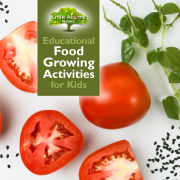
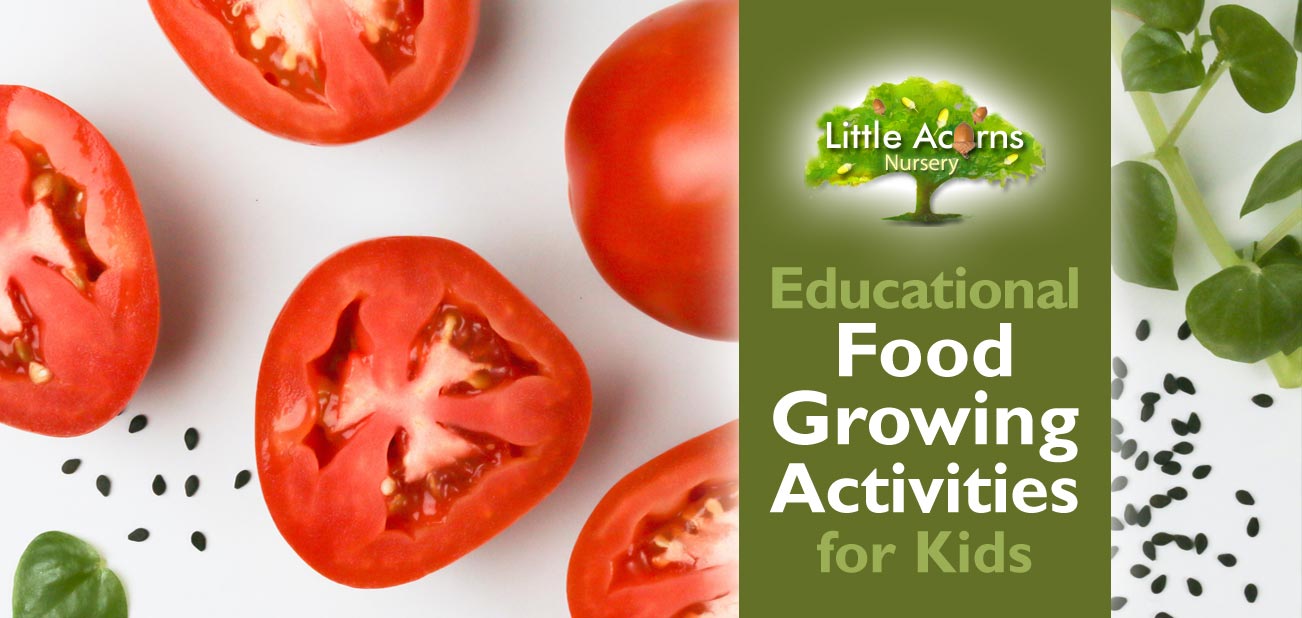
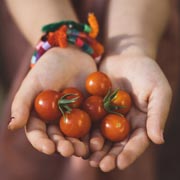 and that’s just one of many reasons why little ones should be encouraged to learn about sowing seeds and growing their own plants. Today, we’re taking that a step further by explaining how children can grow plants that will give them real, edible food! With a little planning, care and effort, children can grow herbs, vegetables and even fruit if they put their minds to it. What’s more, it’s possible without a garden and needn’t cost a penny!
and that’s just one of many reasons why little ones should be encouraged to learn about sowing seeds and growing their own plants. Today, we’re taking that a step further by explaining how children can grow plants that will give them real, edible food! With a little planning, care and effort, children can grow herbs, vegetables and even fruit if they put their minds to it. What’s more, it’s possible without a garden and needn’t cost a penny! That will never be more evident than when a seed has grown into a plant that bears fruit, which contains more seeds, through which the whole process can start again.
That will never be more evident than when a seed has grown into a plant that bears fruit, which contains more seeds, through which the whole process can start again. Seeds for herbs, vegetables and microgreens are all widely retailed in places like garden centres and even some supermarkets. Each seed packet will usually explain when and how seeds can be planted. This is perhaps the most obvious way for children to grow plants that, if all goes well, result in a healthy crop of food. However, we can be far more adventurous than that! Where is the fun in buying seeds in packets when children can get them for free? Let’s take a look at some cheaper and far more creative ways that children can start things off.
Seeds for herbs, vegetables and microgreens are all widely retailed in places like garden centres and even some supermarkets. Each seed packet will usually explain when and how seeds can be planted. This is perhaps the most obvious way for children to grow plants that, if all goes well, result in a healthy crop of food. However, we can be far more adventurous than that! Where is the fun in buying seeds in packets when children can get them for free? Let’s take a look at some cheaper and far more creative ways that children can start things off. “Free” you say? Well, pretty much! Next time you have some shop-bought tomatoes and/or peppers as part of your ordinary shopping, get your little one to take a few moments to save some of the seeds. These are found within things like tomatoes, before they’re eaten, and are usually discarded in the case of peppers. Such seeds can simply be spaced out on some compost or earth, watered in and a thin layer of soil or compost added on top. If these are left on the windowsill and the earth kept moist by the child over the coming days, little seedlings will soon start to appear.
“Free” you say? Well, pretty much! Next time you have some shop-bought tomatoes and/or peppers as part of your ordinary shopping, get your little one to take a few moments to save some of the seeds. These are found within things like tomatoes, before they’re eaten, and are usually discarded in the case of peppers. Such seeds can simply be spaced out on some compost or earth, watered in and a thin layer of soil or compost added on top. If these are left on the windowsill and the earth kept moist by the child over the coming days, little seedlings will soon start to appear. 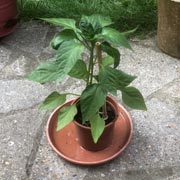 The image of the green plant shows our pepper seedling grown in this exact way — and it was incredibly easy to achieve. Ours is about 3 or 4 weeks old and it’s just about ready to be “planted out” outdoors, to mature. Once mature, they should flower then sprout some new peppers! It’s identical for tomatoes. If children have no garden for larger plants to be transferred to, ‘grow bags’ or any kind of suitable container can be used on a patio or balcony. Children will need to keep watering them every day, to keep the soil moist. Flowers will eventually appear and, with a little help from bees and insects, will be pollinated so that they eventually ‘fruit’. If appropriate care and attention continues, your child will eventually end up with vegetables that can eventually ripen and be eaten. That’s free tomatoes and peppers for the family, in our examples. Don’t forget to remind your child to save a few more seeds, though, so they can repeat the whole process again … and again!
The image of the green plant shows our pepper seedling grown in this exact way — and it was incredibly easy to achieve. Ours is about 3 or 4 weeks old and it’s just about ready to be “planted out” outdoors, to mature. Once mature, they should flower then sprout some new peppers! It’s identical for tomatoes. If children have no garden for larger plants to be transferred to, ‘grow bags’ or any kind of suitable container can be used on a patio or balcony. Children will need to keep watering them every day, to keep the soil moist. Flowers will eventually appear and, with a little help from bees and insects, will be pollinated so that they eventually ‘fruit’. If appropriate care and attention continues, your child will eventually end up with vegetables that can eventually ripen and be eaten. That’s free tomatoes and peppers for the family, in our examples. Don’t forget to remind your child to save a few more seeds, though, so they can repeat the whole process again … and again! Does your little one know that he/she can grow new herb plants totally free of charge? This is done simply by clipping cuttings from your usual shop-bought herbs and leaving them in water to root. It’s incredibly easy so long as the child has some patience (that’s another useful lesson for them). All the child needs to do is to save some small (3 or 4 inch long) cuttings from the tips of herbs like basil or coriander. For safety, parents/carers may need to help with the cutting part if the children are very young.
Does your little one know that he/she can grow new herb plants totally free of charge? This is done simply by clipping cuttings from your usual shop-bought herbs and leaving them in water to root. It’s incredibly easy so long as the child has some patience (that’s another useful lesson for them). All the child needs to do is to save some small (3 or 4 inch long) cuttings from the tips of herbs like basil or coriander. For safety, parents/carers may need to help with the cutting part if the children are very young. 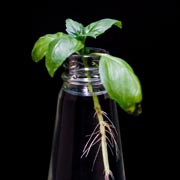 The bottom sections of the clipped cuttings should be dangled into a glass, small bottle or other suitable vessel of water and left over a period of days until they sprout roots. See the photo for an example. A clear water vessel, e.g. drinking glass, will allow your child to clearly see the roots. Once suitably long, these new little plants can be transplanted individually into compost/soil in something like flower pots — or indeed a free, recycled alternative like a yoghurt pot. The little ones will need to continue attending to the plants with regular watering so that the herbs grow and mature. This activity can all be done indoors on a windowsill too, so requires minimal space. Growing their own herbs may even make children more inclined to eat them!
The bottom sections of the clipped cuttings should be dangled into a glass, small bottle or other suitable vessel of water and left over a period of days until they sprout roots. See the photo for an example. A clear water vessel, e.g. drinking glass, will allow your child to clearly see the roots. Once suitably long, these new little plants can be transplanted individually into compost/soil in something like flower pots — or indeed a free, recycled alternative like a yoghurt pot. The little ones will need to continue attending to the plants with regular watering so that the herbs grow and mature. This activity can all be done indoors on a windowsill too, so requires minimal space. Growing their own herbs may even make children more inclined to eat them!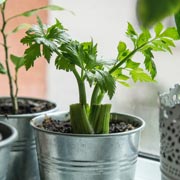 Another ridiculously easy way to grow food is to “re-grow” it. A classic example of this is to save the root section from a salad vegetable like iceberg lettuce or celery. This is the part of a shop-bought vegetable that would normally be cut off and discarded. However, in what has to be the easiest food growing activity of all, the child simply needs to keep that root section and leave it root down in water for 1 to 3 weeks. It will eventually grow some roots but, before that, the upper tip will start to sprout new leaves. In our own test using an iceberg lettuce we ended up with loads! That is new, free salad that can be later harvested and eaten. Simple!
Another ridiculously easy way to grow food is to “re-grow” it. A classic example of this is to save the root section from a salad vegetable like iceberg lettuce or celery. This is the part of a shop-bought vegetable that would normally be cut off and discarded. However, in what has to be the easiest food growing activity of all, the child simply needs to keep that root section and leave it root down in water for 1 to 3 weeks. It will eventually grow some roots but, before that, the upper tip will start to sprout new leaves. In our own test using an iceberg lettuce we ended up with loads! That is new, free salad that can be later harvested and eaten. Simple! (Speaking of iceberg lettuces): Excuse the pun, but the ideas above are just the tip of the iceberg! There are so many other types of vegetable and fruit that children can grow (or re-grow) for next to nothing. For example, they can grow new apple trees from apple pips and new strawberry plants from the outside skin of strawberries. And the whole topic of
(Speaking of iceberg lettuces): Excuse the pun, but the ideas above are just the tip of the iceberg! There are so many other types of vegetable and fruit that children can grow (or re-grow) for next to nothing. For example, they can grow new apple trees from apple pips and new strawberry plants from the outside skin of strawberries. And the whole topic of 